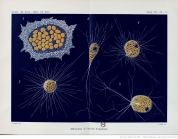WoRMS taxon details
Iridia Heron-Allen & Earland, 1914
204583 (urn:lsid:marinespecies.org:taxname:204583)
accepted
Genus
Iridia diaphana Heron-Allen & Earland, 1914 (type by original designation)
- Species Iridia convexa Cushman, 1919
- Species Iridia diaphana Heron-Allen & Earland, 1914
- Species Iridia lucida Le Calvez, 1936
- Species Iridia serialis Le Calvez, 1935
marine, brackish, fresh, terrestrial
feminine
Heron-Allen, E.; Earland, A. (1914). The Foraminifera of the Kerimba Archipelago (Portuguese East Africa) -Part I. <em>Transactions of the Zoological Society of London.</em> 20(12): 363-390.
page(s): p. 371 [details]
page(s): p. 371 [details]
Hayward, B.W.; Le Coze, F.; Vachard, D.; Gross, O. (2024). World Foraminifera Database. Iridia Heron-Allen & Earland, 1914. Accessed through: World Register of Marine Species at: https://www.marinespecies.org/aphia.php?p=taxdetails&id=204583 on 2024-04-19
Date
action
by
2006-09-13 06:47:38Z
changed
Martinez, Olga
![]() The webpage text is licensed under a Creative Commons Attribution 4.0 License
The webpage text is licensed under a Creative Commons Attribution 4.0 License
original description
Heron-Allen, E.; Earland, A. (1914). The Foraminifera of the Kerimba Archipelago (Portuguese East Africa) -Part I. <em>Transactions of the Zoological Society of London.</em> 20(12): 363-390.
page(s): p. 371 [details]
basis of record Neave, Sheffield Airey. (1939-1996). Nomenclator Zoologicus vol. 1-10 Online. <em>[Online Nomenclator Zoologicus at Checklistbank. Ubio link has gone].</em> , available online at https://www.checklistbank.org/dataset/126539/about [details]
page(s): p. 371 [details]
basis of record Neave, Sheffield Airey. (1939-1996). Nomenclator Zoologicus vol. 1-10 Online. <em>[Online Nomenclator Zoologicus at Checklistbank. Ubio link has gone].</em> , available online at https://www.checklistbank.org/dataset/126539/about [details]
From editor or global species database
Diagnosis Test attached, a hemispherical or irregular chamber with short tubular to branching projections; wall proteinaceous, consisting of a fibrillar lamina propria, formed by endoplasm, and an outer perilamina produced by the ectoplasm and pseudopodia, may include agglutinated particles; apertures at ends of tubular projections; pseudopodia elongate, bifurcating, and arising from a stomostyle or pseudopodial trunk; during asexual reproduction young embryos become temporarily pelagic and have radiating, nonanastomosing pseudopodia, later the pseudopodia are withdrawn, the embryo attaches to the substrate and forms a test; during sexual reproduction gametes with two laterally attached unequal flagella unite to form a diploid schizont that is morphologically like the gamont. Holocene; Africa: Kerimba Archipelago; Caribbean; Mediterranean. (Loeblich & Tappan, 1987, Foraminiferal Genera and Their Classification) [details]
